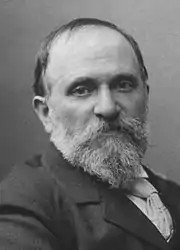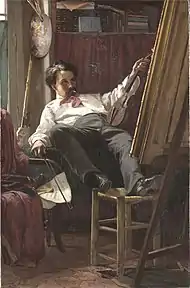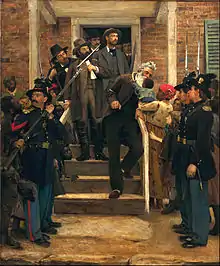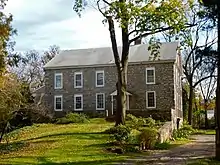Thomas Hovenden
Thomas Hovenden (December 28, 1840 – August 14, 1895), was an Irish artist and teacher. He painted realistic quiet family scenes, narrative subjects and often depicted African Americans.
Thomas Hovenden | |
|---|---|
 Thomas Hovenden in 1895 | |
| Born | December 28, 1840 |
| Died | August 14, 1895 (aged 54) |
| Nationality | Irish |
| Education | Cork School of Design National Academy of Design École des Beaux Arts under Cabanel |
| Known for | Painting |
Notable work | The Last Moments of John Brown (1884) Breaking Home Ties (1890) |
| Spouse(s) | Helen Corson Hovenden |
Biography

Hovenden was born in Dunmanway, Co. Cork, Ireland.[1] His parents died at the time of the Great Famine and he was placed in an orphanage at the age of six. Apprenticed to a carver and gilder, he studied at the Cork School of Design.
In 1863, he immigrated to the United States. He studied at the National Academy of Design in New York City.[1] He moved to Baltimore in 1868 and then left for Paris in 1874. He studied at the École des Beaux Arts under Cabanel, but spent most of his time with the American art colony at Pont-Aven in Brittany led by Robert Wylie, where he painted many pictures of the peasantry.[1]
Returning to America in 1880, he became a member of the Society of American Artists and an Associate member of the National Academy of Design[1] (elected Academician in 1882). He married Helen Corson in 1881, an artist he had met in Pont-Aven, and settled at her father's homestead in Plymouth Meeting, Pennsylvania, outside of Philadelphia. She came from a family of abolitionists and her home was a stop on the Underground Railroad. Their barn, later used as Hovenden's studio, was known as "Abolition Hall" due to its use for anti-slavery meetings.[2]
He was commissioned by Mr. Robbins Battell[3] to paint a historical picture of the abolitionist leader John Brown. He finished The Last Moments of John Brown (at least two copies exist, in the collection of the deYoung Museum in San Francisco and also the Metropolitan Museum in New York)[1] in 1884.[4] Gift of Mr. and Mrs. Carl Stoeckel in 1897. Accession Number 97.5 Mrs. Stoeckel was Mr. Battell's daughter. His Breaking Home Ties, a picture of American farm life, was engraved with considerable popular success.[1]
In 1886, he was appointed Professor of Painting and Drawing at the Pennsylvania Academy of the Fine Arts, replacing Thomas Eakins who was dismissed due to his use of nude models. Among Hovenden's students were the sculptor Alexander Stirling Calder and the leader of the Ashcan School, Robert Henri.
Hovenden was killed at the age of 54, along with a ten-year-old girl, by a railroad locomotive at a crossing near his home in Plymouth Meeting. Newspaper accounts reported that his death was the result of a heroic effort to save the girl,[1] while a coroner's inquest determined his death was an accident.[2]
A Pennsylvania state historical marker in Plymouth Meeting interprets Abolition Hall and Hovenden.[5] Hovenden House, Barn and Abolition Hall was added to the National Register of Historic Places in 1971.[6] He is buried across the street in the cemetery of the Plymouth Friends Meetinghouse.[7]
Selected works
- Self-Portrait of the Artist in His Studio, 1875, Yale University Art Gallery
- Image Seller, 1876, Metropolitan Museum of Art
- News from the Conscript, 1877
- Loyalist Peasant Soldier of La Vendée, 1877
- A Breton Interior, 1793, 1878, Metropolitan Museum of Art
- In Hoc Signo Vinces, 1880, Detroit Institute of Arts, Michigan
- The Old Version, 1881, San Francisco Museum of Fine Art
- Sunday Morning, 1881, San Francisco Museum of Fine Art
- Chloe and Sam, 1882, Amon Carter Museum
- Death of Elaine,[8] 1882, Westmoreland Museum of American Art, Pennsylvania
- The Last Moments of John Brown, 1882-4, Metropolitan Museum of Art
- Taking His Ease, 1885, San Francisco Museum of Fine Art
- Breaking Home Ties, 1890, Philadelphia Museum of Art
- Bringing Home the Bride, 1893, University of St. Thomas, St. Paul, Minnesota
- Jerusalem the Golden, 1894, Metropolitan Museum of Art
 The Last Moments of John Brown (1884). The original painting is in the collection of the Metropolitan Museum of Art, while a 2/3 size copy is at the Fine Arts Museums of San Francisco.
The Last Moments of John Brown (1884). The original painting is in the collection of the Metropolitan Museum of Art, while a 2/3 size copy is at the Fine Arts Museums of San Francisco. Hovenden House, Plymouth Meeting, Pennsylvania. He lived here from his marriage in 1881 to his death in 1895.
Hovenden House, Plymouth Meeting, Pennsylvania. He lived here from his marriage in 1881 to his death in 1895. Hovenden's studio, Plymouth Meeting, Pennsylvania.
Hovenden's studio, Plymouth Meeting, Pennsylvania. Chloe and Sam (1882), Amon Carter Museum.
Chloe and Sam (1882), Amon Carter Museum._-_Breaking_Home_Ties_-_Google_Art_Project.jpg.webp) Breaking Home Ties (1890), Philadelphia Museum of Art.
Breaking Home Ties (1890), Philadelphia Museum of Art. I Know'd It Was Ripe (c.1885), Brooklyn Museum.
I Know'd It Was Ripe (c.1885), Brooklyn Museum.
References
- Chisholm, Hugh, ed. (1911). . Encyclopædia Britannica. 13 (11th ed.). Cambridge University Press. p. 829.
- Thomas Hovenden: American Painter of Hearth and Homeland, Woodmere Art Museum, Philadelphia, 1995. ISBN 1-888008-00-8.
- See: Norfolk, Connecticut
- A replica of the painting is at the Fine Arts Museums of San Francisco.
- Abolition Hall marker
- "National Register Information System". National Register of Historic Places. National Park Service. July 9, 2010.
- "National Historic Landmarks & National Register of Historic Places in Pennsylvania" (Searchable database). CRGIS: Cultural Resources Geographic Information System. Note: This includes Helen Reichart Mirras (December 1969). "National Register of Historic Places Inventory Nomination Form: Plymouth Friends Meetinghouse" (PDF). Retrieved 2012-05-24.
- Schantz, Michael. "Thomas Hovenden: American Painter of Hearth and Homeland". Traditional Fine Arts Organization. Retrieved 10 January 2019.
External links
| Wikimedia Commons has media related to Thomas Hovenden. |
- "Thomas Hovenden Killed," The Pittsburgh Press, 15 August 1895.
- . New International Encyclopedia. 1905.
- www.abolitionhall.com
